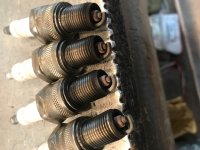Stop fiddling with the carbs looking for the ultimate. If it runs good and the plugs are close to the right color - leave it alone!
pd, I don't think you have had the miraculous opportunity work with the Wonderful SUs of the emission era. It truly will send you thru an epiphany. I am attaching a pic of the B's spark plugs for you perusal while we discuss this. The carbs are HIFs. The wonderful invention of the emission era.
These HIFs have a bi-metal piece inside that thru the enlightenment of engineers at the time decides to lean the jets relative to Temperature. Now I don't think that I am overly tweedly when it comes to carburators, but these bimetal pieces have a mind of there own. So here's the story.
These carbs were very rich when I bought the car. So I leaned them up a bit and the car ran fine. This spring when I dug the car out, the carbs were rich again. So I gave the car a complete tune-up
including points, condenser, rotor, cap and timing. Then also readjusted the carbs. Previous to this the plugs showed a lot of carbon. I didn't even clean them when I did the ignition. After adjusting the carbs, the car ran so well that it even cleaned the plugs and they look as they do in the pic. So the other day I drove it to a friends place about 8 miles away confident that the tune was just right. I ran beautifully. My friend and I where standing in his driveway and the B was idling next to us. Idling well I must say. As we talked we both looked at the car, then at each other and thought what is going on with the car. All of a sudden from perfect idle it started loping, slowing in idle speed, acting rich, and puffing a little black smoke. We looked at each other and shook our heads.
So drove it home which was at moderately slow speeds since I was driving thru subdivisions, the 8 miles to home at slow rpms certainly would have given it time to load up also. When I got home I pulled the plugs and the pic is what they looked like. They don't look carboned up to me. I think they look pretty good considering the gasoline we have. So what's going on? Me thinks it might be that little dastardly emission era bimetal piece.
If your not familiar with it, the HIF carb doesn't have a jet sticking out the bottom. It doesn't have the jet adjusting nut on the bottom. The jet is adjusted by turning a screw that is in the side of the carb horizontally. And the screw doesn't act directly on the jet. It pushes on an "L" shaped bi-metal piece which when the screw is turned in it pushes the jet up, and pulls it down when turned out. But the "GENIUS" to the bi-metal strip is that as the strip warms up it pushes the jet up there-by leaning the carb. Therefore as the engine warms it runs leaner and reduces it's noxious stuff. Isn't that wonderful. But the bi-metal piece has a mind of its own.
Now here's my theory. When I have been adjusting the carbs the engine is probably pretty warm. I mean, my gosh, isn't that what your suppose to do when adjusting carbs make sure the engine is warmed up? So as I am adjusting the carbs the bi-metal piece is probably in its lean state, if it is working as it should (who knows). So I get it adjusted up to running pretty good and when the bi-metal piece goes back to its rich state, it is too rich. Or something like that. Or maybe that piece is just moving around at will and changing the jet. I looked at another HIF carb the other day to see what this thing looks like inside. If I do take these carbs apart, it will be for the purpose of trying to eliminate or reduce the influence of that bi-metal piece. I may solder the two bi-metals together to eliminate their movement. So that's my story. Dave.

 Hi Guest!
Hi Guest!

 smilie in place of the real @
smilie in place of the real @
 Pretty Please - add it to our Events forum(s) and add to the calendar! >>
Pretty Please - add it to our Events forum(s) and add to the calendar! >> 




